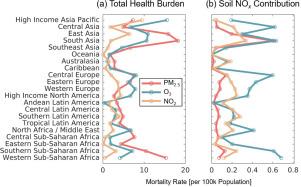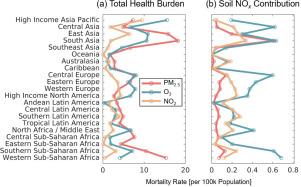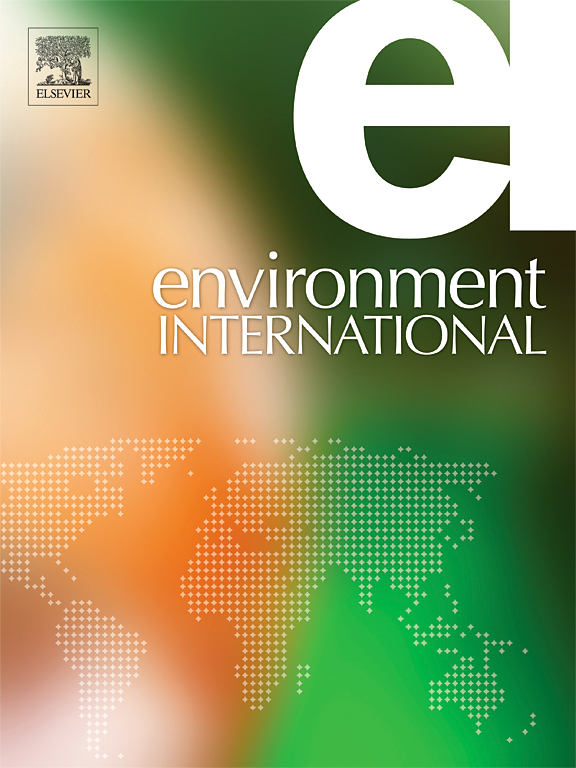Underappreciated roles of soil nitrogen oxide emissions on global acute health burden
IF 10.3
1区 环境科学与生态学
Q1 ENVIRONMENTAL SCIENCES
引用次数: 0
Abstract
The recognized importance of ambient fine particulate matter (PM2.5), ozone (O3), and nitrogen dioxide (NO2) on human health has prompted the world to enact increasingly strict regulations on anthropogenic nitrogen oxides (NOx) emissions. However, the health concerns from soil NOx, potentially driven by fertilizer input but conventionally categorized as natural sources, remain less studied. Here, we emphasize the underappreciated roles of soil NOx emissions on health burden attributable to short-term PM2.5, O3, and NO2 exposure. Globally, we quantify acute health effects using machine-learning-based daily exposure estimates and identify influences of soil NOx emissions based on chemical transport model simulations. We find that 72.3% of the globe is affected by soil NOx emissions, whose contributions to short-term PM2.5, O3, and NO2 pollution lead to 13.9 (95% Confidence Interval [CI]: 9.1–18.8), 26.0 (18.2–34.2), and 13.9 (10.3–17.5) thousand premature mortality, respectively, in 2019. With distinct variations in regions, seasons, and pollutants, soil NOx-originated air pollution poses a global health concern, particularly for developing regions and intensively agricultural areas. In response to the intensive fertilizer use, South Asia, Southern Sub-Saharan Africa, and Central Europe witness the largest soil NOx-related health burden of up to 1.6 (95% CI: 1.1–2.1) mortality per 100k population. The overall health risk peaks in May, with O3 pollution typically dominating the soil NOx-attributable health burden during warm seasons and NO2 or PM2.5 during cold months. Our study highlights the necessity of dynamically adapted agricultural strategies for health-oriented multi-pollutant control, among which the improved use of synthetic fertilizers deserves priority under the ever-changing climate.


土壤氮氧化物排放对全球急性健康负担的作用未得到充分重视
环境中的细颗粒物(PM2.5)、臭氧(O3)和二氧化氮(NO2)对人类健康的重要性已得到公认,这促使世界各国对人为的氮氧化物(NOx)排放制定了越来越严格的法规。然而,对土壤氮氧化物对健康的影响的研究仍然较少,这些氮氧化物可能是由化肥投入造成的,但传统上被归类为自然来源。在此,我们强调土壤氮氧化物排放对短期 PM2.5、O3 和 NO2 暴露所造成的健康负担的作用未得到充分重视。在全球范围内,我们使用基于机器学习的每日暴露估计值对急性健康影响进行量化,并根据化学迁移模型模拟确定土壤氮氧化物排放的影响。我们发现,全球 72.3% 的地区受到土壤氮氧化物排放的影响,其对短期 PM2.5、O3 和 NO2 污染的贡献分别导致 2019 年 13.9(95% 置信区间 [CI]:9.1-18.8)、26.0(18.2-34.2)和 13.9(10.3-17.5)万人过早死亡。土壤氮氧化物引起的空气污染因地区、季节和污染物的不同而存在明显差异,是一个全球性的健康问题,尤其是在发展中地区和农业密集地区。由于化肥的大量使用,南亚、撒哈拉以南非洲南部和中欧地区与土壤氮氧化物相关的健康负担最大,每 10 万人的死亡率高达 1.6(95% CI:1.1-2.1)。总体健康风险在 5 月份达到峰值,通常在温暖的季节,O3 污染在土壤氮氧化物导致的健康负担中占主导地位,而在寒冷的月份,NO2 或 PM2.5 则占主导地位。我们的研究强调了动态调整农业战略的必要性,以健康为导向控制多种污染物,其中,在不断变化的气候条件下改进合成肥料的使用值得优先考虑。
本文章由计算机程序翻译,如有差异,请以英文原文为准。
求助全文
约1分钟内获得全文
求助全文
来源期刊

Environment International
环境科学-环境科学
CiteScore
21.90
自引率
3.40%
发文量
734
审稿时长
2.8 months
期刊介绍:
Environmental Health publishes manuscripts focusing on critical aspects of environmental and occupational medicine, including studies in toxicology and epidemiology, to illuminate the human health implications of exposure to environmental hazards. The journal adopts an open-access model and practices open peer review.
It caters to scientists and practitioners across all environmental science domains, directly or indirectly impacting human health and well-being. With a commitment to enhancing the prevention of environmentally-related health risks, Environmental Health serves as a public health journal for the community and scientists engaged in matters of public health significance concerning the environment.
 求助内容:
求助内容: 应助结果提醒方式:
应助结果提醒方式:


